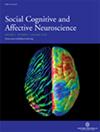Exposure to Community Violence as a Mechanism Linking Neighborhood Socioeconomic Disadvantage and Neural Responses to Reward
IF 3.1
2区 医学
Q2 NEUROSCIENCES
引用次数: 0
Abstract
A growing literature links socioeconomic disadvantage and adversity to brain function, including disruptions in reward processing. Less research has examined exposure to community violence as a specific adversity related to differences in reward-related brain activation, despite the prevalence of community violence exposure for those living in disadvantaged contexts. The current study tested whether exposure to community violence was associated with reward-related ventral striatum activation after accounting for familial factors associated with differences in reward-related activation (e.g., parenting, family income). Moreover, we tested whether exposure to community violence is a mechanism linking socioeconomic disadvantage to reward-related activation in the ventral striatum. We utilized data from 444 adolescent twins sampled from birth records and residing in neighborhoods with above-average levels of poverty. Exposure to community violence was associated with greater reward-related ventral striatum activation, and the association remained after accounting for family-level markers of disadvantage. We identified an indirect pathway in which socioeconomic disadvantage predicted greater reward-related activation via greater exposure to community violence, over and above family-level adversity. These findings highlight the unique impact of community violence exposure on reward processing and provide a mechanism through which socioeconomic disadvantage may shape brain function.暴露于社区暴力是连接邻里社会经济劣势和奖赏神经反应的机制
越来越多的文献将社会经济劣势和逆境与大脑功能(包括奖赏处理过程中的干扰)联系起来。尽管生活在不利环境中的人普遍遭受社区暴力,但将遭受社区暴力作为与奖赏相关的大脑激活差异有关的特定逆境的研究较少。本研究测试了在考虑了与奖赏相关激活差异有关的家庭因素(如养育、家庭收入)后,社区暴力暴露是否与奖赏相关的腹侧纹状体激活有关。此外,我们还检验了暴露于社区暴力是否是社会经济劣势与腹侧纹状体奖赏相关激活的一种关联机制。我们利用了从出生记录中抽取的、居住在贫困水平高于平均水平的社区的 444 对青少年双胞胎的数据。暴露于社区暴力与更大的奖赏相关腹侧纹状体激活有关,在考虑了家庭层面的劣势标记后,这种关联仍然存在。我们发现了一个间接的途径,即社会经济劣势通过更多的社区暴力暴露来预测更高的奖赏相关激活,而不是家庭层面的逆境。这些发现凸显了接触社区暴力对奖赏处理的独特影响,并提供了一种社会经济劣势可能影响大脑功能的机制。
本文章由计算机程序翻译,如有差异,请以英文原文为准。
求助全文
约1分钟内获得全文
求助全文
来源期刊
CiteScore
6.80
自引率
4.80%
发文量
62
审稿时长
4-8 weeks
期刊介绍:
SCAN will consider research that uses neuroimaging (fMRI, MRI, PET, EEG, MEG), neuropsychological patient studies, animal lesion studies, single-cell recording, pharmacological perturbation, and transcranial magnetic stimulation. SCAN will also consider submissions that examine the mediational role of neural processes in linking social phenomena to physiological, neuroendocrine, immunological, developmental, and genetic processes. Additionally, SCAN will publish papers that address issues of mental and physical health as they relate to social and affective processes (e.g., autism, anxiety disorders, depression, stress, effects of child rearing) as long as cognitive neuroscience methods are used.

 求助内容:
求助内容: 应助结果提醒方式:
应助结果提醒方式:


